Aventuras De Viaje's Blog, page 42
January 22, 2015
26 Top Things to do in Singapore
Top things to do in Singapore including directions, estimated costs, cheap accommodation in Singapore and other useful information on how to survive travel in Singapore.
Top Things to Do in SingaporeI enjoyed Singapore much more than I expected. Although it is more expensive than most other parts of Asia, there was lots to see and do and plenty of good food. A big bonus is that nearly everyone can speak English.
Anyway, here it is, my list of 26 top things to do in Singapore.
Top Things to Do in Singapore #1. Lurut Rd Swap MeetCost: Free (unless you buy stuff)
On the corner of Lurut Rd and Arab is a kind of swap meet. Seems to be mainly just a way for the sellers to past time in their retirement selling what looks like stolen stuff mixed with random junk. Good for a look although it did get me sidetracked from finding my accommodation from the airport.
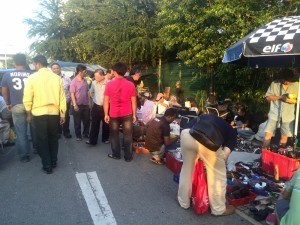
Lurut Road has a daily ‘junk’ sale.
Top Things to do in Singapore #2. Little IndiaCost: Free (unless you buy stuff)
After checking in I went for a walk around the general area, with the purpose of finding Little India for a feed.
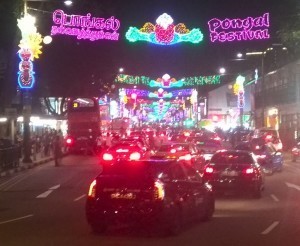
At the time I was there, the Pongol Festival was on in Little India.. although I’m not sure what the Pongol Festival is about.
It wasn’t hard to find and the Pongol Festival was on so I saw a few painted cows.
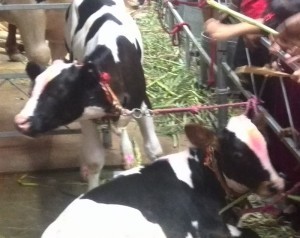
A painted cow for Pongol Festival
Top Things to do in Singapore #3. Sri Veeramakaliamman TempleCost: Free
On the corner of Belilios and Serangoon is the Sri Veeramakaliamman Temple. It was kind of surreal with the singing and a cool experience since I’ve never been to an Indian temple before. Can’t wait until I go explore India.
Top Things to do in Singapore #4. Victoria StreetCost: Free (unless you buy stuff)
Take a walk up Victoria Street for all your shopping needs. Not really my thing I understand how lots of people would love it.
Top Things to do in Singapore #5. Bugis Street MarketsCost: Free (unless you buy stuff)
This is more my scene as far as shopping goes. Bustling and full of tourist stuff, as well as my favorite… snacks.
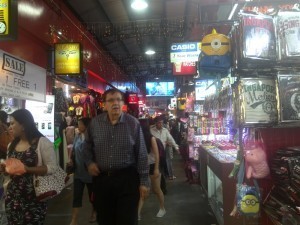
Bugis Street markets has lots of things to buy and may favorite… snacks!
Top Things to do in Singapore #6. Kent Ridge ParkCost: Free
Kent Ridge park was nice, and although I didn’t actually see any, there is the chance of spotting monkeys and monitor lizards there.
My highlight was the canopy walk. I had forgotten how nice it is to just stare into the jungle, reminded me of my army days.
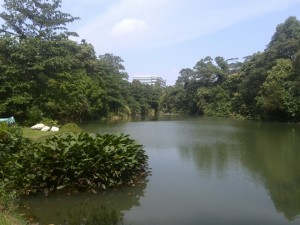
Just one of the many beautiful pieces of scenery at Kent Ridge
Getting to Kent Ridge ParkFrom the B88 Hostel (where I stayed) take the metro from Bugis to Paya Lebar (towards Pasir Ris).
Swap trains at Paya Lebar to the Circle Line heading towards Harbour Front. Get off at Kent Ridge. The journey took about an hour.
Take exit B and turn left. Turn left (East) on Science Park Drive for about 10 minutes until you hit the park on your right.
Look at monkey sign, then the map. Follow the red route (or whatever)
Top Things to do in Singapore #7. World War 2 Interpretative CenterCost: I don’t know
I didn’t go in but so I can’t comment on how good it is, but it is something to do none the less, and is probably pretty good especially if you are interested in WW2 history.
Top Things to do in Singapore #8. Toy MuseumCost $15SGD
The toy museum was pretty good. Consists of 5 floors of different toys, mostly TV and cartoon characters. One section that amused me was a bit of a time machine to back when the word Nigger was used very loosely in the United States (mostly the South I imagine). Wouldn’t get away with toys like those these days (and nor should they.. racist f*ks!)


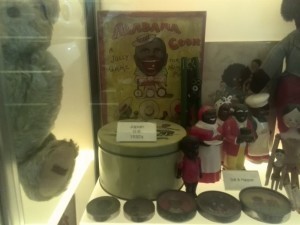
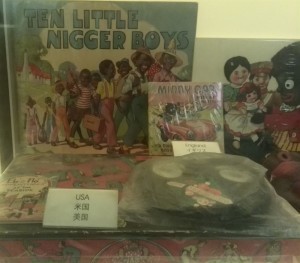
Next door to toy factory is a good place to get Hianese Chicken Rice. Set me back $8SGD.
Getting to the Toy MuseumTake Circle Line 8 towards Dhoby Ghaut and get off at the Esplanade stop. Take exit F towards the Raffles Hotel. From Kent Park this took about 50 minutes.
Go NW on Bras Basah and then right on North Bridge Rd and then Right on Seah St.
Top Things to do in Singapore #9. Eat Singaporean FoodCost: I don’t know… how much do you eat?
Thanks to their diverse culture, Singapore is a melting pot of delicious foods from India, Malaysia, China as well as a good selection of western fare. I think you could find most things here.
You can check out all the food I tried in the Amazing Foods of Singapore post.
Top Things to do in Singapore #10. Check Out the EsplanadeCost: Free, unless you buy stuff
There’s a lot going on at the Esplanade, and I happened to be there during the arts festival. There was live acoustics at the concourse and they had a full calendar of free stuff. I expect this is true even when the arts festival isn’t on also.
Getting to the EsplanadeAs you walk out of the Toy Museum (#8 of the top things to do in Singapore), turn left (on Seah). Turn right on Stamford. Go past the war memorial, left on Beach Road, right on Esplanade Drive, through the underpass which seems to be just a general hangout with people dancing, praying, singing, sleeping playing badminton etc, and then take exit D to the Esplanade.
Top Things to do in Singapore #11. River CruiseCost: $25SGD
I’m not sure how I felt about this. There was some good information but not sure if it was worth the $25SGD. The cruise goes for about 45 minutes and you can get off and back on once.
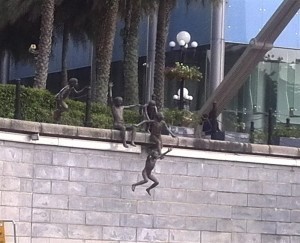
Statues of boys jumping into the river along the river cruise.
Getting to the River CruiseTo get to the River Cruise from the Esplanade, just cross the bridge to the lion (Merlion to be precise) statue that is spitting water.
Unless you really have a hankering for coconut ice-cream, bypass it and get an ice-cream sandwich from on top of the bridge. It is basically a block of ice-cream sandwiched between 2 wafers and comes in 10 or so flavors including blueberry, mango, chocolate, mint, mocha, durian, red bean etc.
Top Things to do in Singapore #12. Clarke QuayCost: Depends on what you buy
Clarke Quay is an upscale area that is pretty nice to walk around. Lots of higher end restaurants and alcohol, although some of the menus I saw where still pretty cheap e.g. $15SGP for a slice of pizza and a beer.
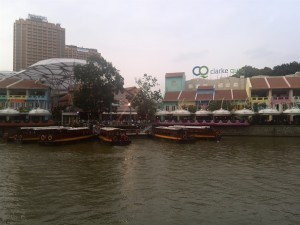
Clarke Quay Nice to walk around with lots of restaurant and bars… a bit too upscale for my liking
Getting to Clarke QuayClark Quay was a stop on the river cruise, and you can easily walk there from the Esplanade.
Alternatively, catch the MRT to Clarke Key station on the NE Line. Exit C by stairs of E if you need an escalator.
Bus 2 and 12 also go there.
Top Things to do in Singapore #13. Marina Sands CasinoCost: Possibly your soul
The actual casino didn’t interest me much, nor did the upper class shopping center surrounding it, but I’m sure lots of people are interested. Also, there is a pretty good food court and some other good attractions around it.
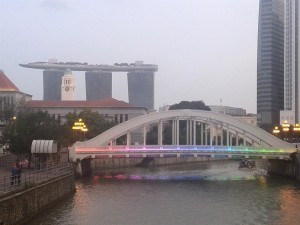
The building with the big boat on the top… that’s the Marina Sands casino
Getting to the Marina Sands CasinoWalk there from the Esplanade, or the closest MRT is either Esplanade or Marina Bay.
Top Things to do in Singapore #14. Art and Science MuseumCost: $25SGD depending on what you see
An awesome concept combining Art and Science, maybe the only one of its kind in the world (don’t quote me on that).
At the time I was there, it was a Leonardo Da Vinci exhibition, who happens to be one of the few non-fictional characters I look up to. I spent a good amount of time in here. It was heavily air-conditioned… I got cold in a T-shirt.
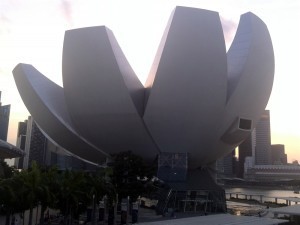
On the 5th floor you can discover why it is shaped the way it is.. which I can not remember
After you see whatever exhibition is on, make sure you check out the 5th floor which tells you about the Museum and has some local art/science stuff. You have to either buy a ticket to an exhibition or the Singapore Eye to see the Art Science museum on the 5th floor.
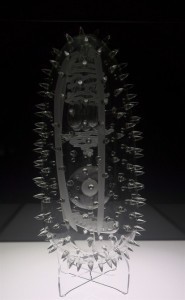
This is what the Malaria strain looks like much larger and blown out of glass
Getting to the Art Science MuseumFrom the Sands Shopping Complex/Casino (#13), just follow the signs.
Top Things to do in Singapore #15. Singapore EyeCost: I don’t know. Probably around $20SGD
Singapore’s version of the London Eye. Possibly bigger. I didn’t do it, but it’s a major attraction none the less.
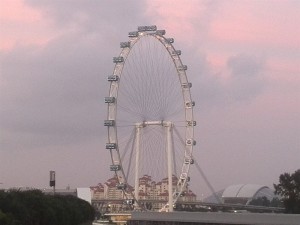
Possibly bigger than the London Eye
Getting to the Singapore EyeBuy tickets from the Art/Science museum ticket sales.
Top Things to do in Singapore #16. Gardens by the BayThe Gardens by the bay greatly exceeded my expectations!
It is kind of hard to describe but is a must see. The park is huge, and come nightfall there is a light/sound show with the ‘crazy trees’ (they have an official name, I just don’t remember what it is) which in my opinion, is better than the Hong Kong riverside laser show.
It reminded me of the Crazy House in Vietnam, but in a large Naturist sense.
Also has 2 conservatories open till 2100 (last ticket sales at 2030). The park itself is free and open from 0500 – 0200.
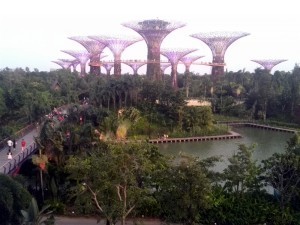
Walking along the bridge only costs $5SGP, but the line was atrocious
Getting to the Gardens by the BayThere are a few ways to get there, just follow the signs from the Sands shopping complex (#13).
I recommend going from the top level of the shopping complex.
Closest MRT is Marina Bay.
Top Things to do in Singapore #17. Pulau UbinCost: Bumboat is $5SGD return, bike hire optional from $5SGD
Pulau Ubin is an island just off the mainland. Pulau is the Malay word for island.
Bike hire is from $5SGD but the more expensive ones are 8. They have signs saying from $2 but I asked and they said 5 was the lowest. Maybe further up the road they do them for 2. No helmet so ride carefully. Pedals level!. Back breaks are on the right and don’t expect gears to work on the cheap ones.
There’s a few things to look at on the island:
Chek Jawa Wetlands. I saw monkeys and pigs on the way. be careful of the monkeys because they steal. Also, don’t get too close to them because they’re territorial.
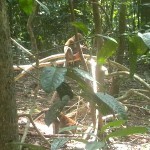

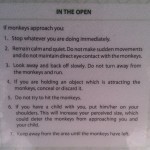
Mangrove and coastal boardwalks. They are both loops which is good.
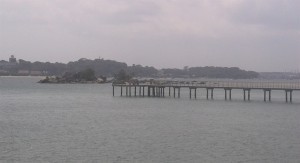
Coastal boardwalk. The mangrove boardwalk was closed for maintenance while I was there.
Camping. There’s several campsites about, and even a beach resort.
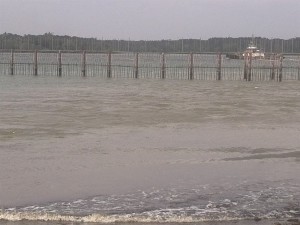
View from Mamman Campsite, which also has an orchid garden and cold drinks (which I did not check out, but they have a sign)
Sensory Trail. A trail with ‘fun facts’ about the plants and stuff along the way.
I spent about 2 and a half hours on Pulau Ubin in total. It’s well planned because everything is in loops. It’s good.
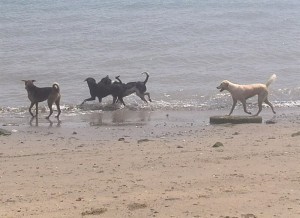
Lifes good for a pack of dogs on Pulau Ubin
Getting to Pulau UbinCatch MRT East West line towards Pasir Ris. Get off at Tanah Merah.
Go to bus station one i.e. when you come down the escalator from the MRT station, turn right.
Catch bus #2 to the Changi Village bus terminal. The journey takes about 30mins.
Turn left off the bus, through the carpark to the ferry terminal, or, walk through the food stalls to get some grub and then follow the signs to the ferry.
Boat costs $2.50SGD one way and takes about 10 minutes.
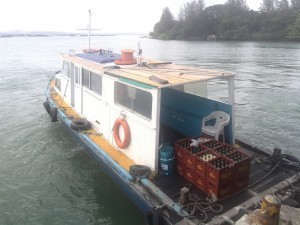
Bumboat to Pulau Ubin fits 12 passengers plus 2 crew
Top Things to do in Singapore #18. Joo ChiatCost: Free to stroll around
Joo Chiat is an area to the east of the city, which is nice for a look around.
Get Laksa from 328 Katong Laksa. It’s famous for it.
Koon Seng Road is between Joo Chiat and Still Rds. It’s a good looking set of houses.
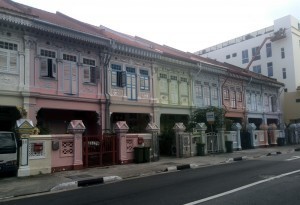
Row of houses in Joo Chiat
Getting to Joo ChatFrom bus stop 2 at Tanah Merah take bus #12 to Roxy Square stop which puts you across the road from the Laksa place.
Bus 12 also leaves from Bugis, I think around Burger King.
Top Things to do in Singapore #19. GeylangCost: Depends on what your after.
Geylang is kind of known as the ‘seedy’ part of Singapore, which is probably why I am attracted to it. I don’t consider myself seedy, but I definitely feel more comfortable in seedy places that posh ones.
Lots of good food there, and at night all the prostitutes come out.
Note: I personally do not hire working girls, but I am not against prostitution, at least not legal prostitution (people that force girls into it are not good!).
As far as I am concerned, if the girl is doing it on her own accord, then good on her. Let her make a buck, after all, it is the oldest profession in the world.
In any case, there are many legal brothels in Geylang, meaning they have licenses (I think) and I suppose it also means the girls are tested (don’t quote me on that). You can tell the houses by the red numbers, usually found on the low numbered side streets of Geylang St e.g. Lorong 12
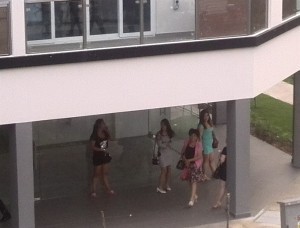
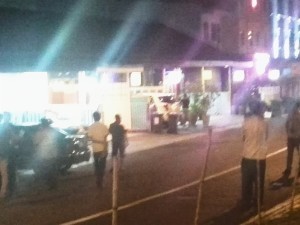 Top Things to do in Singapore #20. MacRitchie Reservoir
Top Things to do in Singapore #20. MacRitchie ReservoirCost: Free
MacRitchie Reservoir was much more than I anticipated with walking/running trails and some other things to do. I could easily have spent 4 or more hours there but I had lot of stuff I wanted to do that day so I decided just to do the treetop walk.
Unfortunately the treetop walk is 5km from the entrance making it a 10km round trip (simple math) which would be at least a 2 hour walk… probably closer to 3.
Instead I just got some Mee Siam from the cafe which set me back $4.50SGP. Watch for monkeys stealing your food… probably best not to sit on the outer tables.
According to Wikitravel.org/en/Singapore the Treetop Walk is open from 9am till 5pm Tuesday to Sunday. Maybe there’s an entry fee also.

MacRitchie Reservoir has lots of trails to explore and some other things
Getting to MacRitchie ReservoirGet to Orchard MRT station on the NS line. Take exit A to Scotts Rd. Cross the road and then catch bus 162 to MacRitchie Reservoir bus stop (Lornie/Thompson Rd).
Top Things to do in Singapore #21. Bukit Timah Nature ReserveCost: Free
I didn’t actually go in but I went past it on the bus. It seems like something I’d of enjoyed if I had a spare day.
Getting to Bukit Timah Nature ReserveFrom the MacRitchie Reseviour go to the other side of the road and catch bus #52 until you get to the Opposite Bukit Timar Plaza stop.
Top Things to do in Singapore #22. Chinese and Japanese GardensCost: Free. Optional $5SGD for live turtle museum.
This was something I nearly didn’t do, but I am really glad I did. In fact, it made it as my favorite of the top things to do in Singapore. It just beat the Gardens by the Bay (#16) because it was alot simpler with hardly anyone there.
The Chinese Garden is open from 0600 – 2300 and the Japanese Garden is open from 0600 – 1900.
In the Chinese Garden you can visit the live turtle museum, which boasts as being the biggest collection of rare turtles (and tortoises I suppose) in the world. I didn’t go in.
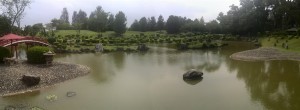
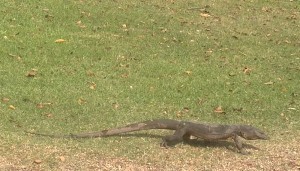 Getting to Chinese and Japanese Gardens
Getting to Chinese and Japanese GardensFrom the MacRitchie Reseviour (#20) go to the other side of the road and catch bus #52 to Clementine Metro Station, then catch the MRT to the Chinese Gardens station.
Top Things to do in Singapore #23. ChinatownA typical Chinatown. Lots to look at, buy and eat. Best at night.
Get food and beer from the 2nd floor of the Chinatown Complex located next to the visitors center and the stage. Lots of choice and cheap. I got Bak Kut Teh with You Tiao which set me back $6SGD. Good selection of Chinese style deserts which you can try also.
Note: Food from the Chinatown Complex closes earlier than the food street, I’m gonna guess around 8 or 9 ish. Beer still available until late. Food street is open till late… at least 11 (again, this is just a guess).
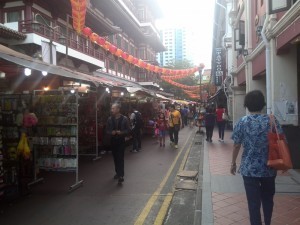
Chinatown has lots to see and do. Food street and markets are best at night.
Getting to ChinatownGet to Chinatown metro station on the NE or Downtown Line.
Come out of the station and walk towards the lanterns. Take a left where it says food street (there’s much more than food).
Top Things to do in Singapore #24. Sim Lim SquareIf you need/want anything electronic related, Sim Lim tower or Sim Lim square is where you want to go.
Sim Lim tower seems to be more for electronic parts and specialized equipment such as 2-way radios, where are Sim Lim square is more for for computers and other consumer electronics.
I need to get my laptop fixed. Whatever you need done, shop around. I got 3 quotes ranging from $30 to $50 SGP.
Getting to Sim LimGet to Bugis Street Station. From there go SW on Victoria St and then turn right onto Rochor Rd. Turn right on Jln Besar and then right onto Sungei Rd. You’ll see it.
Top Things to do in Singapore #25. Albert CourtCost: Depends what you buy.
Albert court is a pedestrian street with a couple of temples, fortune telling, massages, small stalls etc.
There is a good food court there. I ate Cantonese style shredded chicken porridge which also came with You Tiao. It’s kind of funny I chose to eat Cantonese food because I’ve been living in Guangdong (which is the Canton area of China) for the past year and a bit.
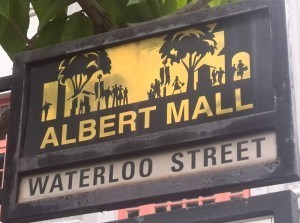
Albert Square. A pedestrian street offering Temples, some small shops, massage etc.
Getting to Albert CourtAlbert Court is opposite Bugis Street Markets (#5)
Top Things to do in Singapore #26. Get PamperedThe last thing on my list of top things to do in Singapore is to pamper yourself. Massages, facials, manicures etc aren’t as cheap here as in the majority of the rest of Asia but is still cheaper than say Australia, UK or America.
I got a pretty good Thai massage from a place called Healing Thai Massage. HealingThaiMassage.com.sg
Healing Thai Massage is strictly a massage… no ‘funny stuff’! For any guys that want a happy ending, just go into the places that advertise Health Spa and have windows painted so it is hard to see in. There are a few of these in Little India and Geylang.
Getting to Healing Thai MassageHealing Thai Massage is at 39 Jln Besar. From Bugis St Station head southwest on Victoria then right on Rochor Rd and then right on Jln Besar.
Other Useful Information About SingaporeHere’s some other useful information about surviving travel in Singapore.
Getting Around SingaporeBuy a Tourist MRT card. It is available for 1, 2 or 3 days and is unlimited travel on trains and buses for those days except on special routes.
It starts when you first use it, and ends at midnight of your last day. Also, if you return the ticket you get $10SGP back.
You can only buy/return the ticket from a ticket office. I’m sure there are a few of them but definitely at Bugis, Chinatown and the airport.
When I first arrived I bought a 3 day pass from the airport (MRT station terminal 2) for $30SGP. I then paid cash for my ticket to my accommodation in Bugis so I wouldn’t ‘waste’ a day of fares.
The single fare ticket from the Airport to Bugis was $2.30 SGP
Cheap Accommodation in SingaporeIf you need cheap accommodation in Singapore, I stayed at the Bugis 88 Hostel and I recommend it. It has pod beds so pretty private and includes personal locker with power point. Free breakfast with toast, fruit and cereal. Free tea and coffee all day and filtered water (although tap water is safe in Singapore. Also, good security and friendly staff. Rooms are air-conditioned and I never had to wait to use the bathroom.
They told me that they are doing upgrades in March 2015 so expect a gym, rooftop Jacuzzi and public bar.
Next Stop… AustraliaI’m going home to Australia for a couple of weeks.. haven’t been back in 3-4 years! First Melbourne for a couple of days then to Perth, my home town.
Well that’s it for this list of top things to do in Singapore. Got anything to add? Put it in the comments 



The post 26 Top Things to do in Singapore appeared first on Survive Travel.
Top Things to do in Singapore
Top things to do in Singapore including directions, estimated costs, cheap accommodation in Singapore and other useful information on how to survive travel in Singapore.
Top Things to Do in SingaporeI enjoyed Singapore much more than I expected. Although it is more expensive than most other parts of Asia, there was lots to see and do and plenty of good food. A big bonus is that nearly everyone can speak English.
Anyway, here it is, my list of 26 top things to do in Singapore.
Top Things to Do in Singapore #1. Lurut Rd Swap MeetCost: Free (unless you buy stuff)
On the corner of Lurut Rd and Arab is a kind of swap meet. Seems to be mainly just a way for the sellers to past time in their retirement selling what looks like stolen stuff mixed with random junk. Good for a look although it did get me sidetracked from finding my accommodation from the airport.

Lurut Road has a daily ‘junk’ sale.
Top Things to do in Singapore #2. Little IndiaCost: Free (unless you buy stuff)
After checking in I went for a walk around the general area, with the purpose of finding Little India for a feed.

At the time I was there, the Pongol Festival was on in Little India.. although I’m not sure what the Pongol Festival is about.
It wasn’t hard to find and the Pongol Festival was on so I saw a few painted cows.

A painted cow for Pongol Festival
Top Things to do in Singapore #3. Sri Veeramakaliamman TempleCost: Free
On the corner of Belilios and Serangoon is the Sri Veeramakaliamman Temple. It was kind of surreal with the singing and a cool experience since I’ve never been to an Indian temple before. Can’t wait until I go explore India.
Top Things to do in Singapore #4. Victoria StreetCost: Free (unless you buy stuff)
Take a walk up Victoria Street for all your shopping needs. Not really my thing I understand how lots of people would love it.
Top Things to do in Singapore #5. Bugis Street MarketsCost: Free (unless you buy stuff)
This is more my scene as far as shopping goes. Bustling and full of tourist stuff, as well as my favorite… snacks.

Bugis Street markets has lots of things to buy and may favorite… snacks!
Top Things to do in Singapore #6. Kent Ridge ParkCost: Free
Kent Ridge park was nice, and although I didn’t actually see any, there is the chance of spotting monkeys and monitor lizards there.
My highlight was the canopy walk. I had forgotten how nice it is to just stare into the jungle, reminded me of my army days.

Just one of the many beautiful pieces of scenery at Kent Ridge
Getting to Kent Ridge ParkFrom the B88 Hostel (where I stayed) take the metro from Bugis to Paya Lebar (towards Pasir Ris).
Swap trains at Paya Lebar to the Circle Line heading towards Harbour Front. Get off at Kent Ridge. The journey took about an hour.
Take exit B and turn left. Turn left (East) on Science Park Drive for about 10 minutes until you hit the park on your right.
Look at monkey sign, then the map. Follow the red route (or whatever)
Top Things to do in Singapore #7. World War 2 Interpretative CenterCost: I don’t know
I didn’t go in but so I can’t comment on how good it is, but it is something to do none the less, and is probably pretty good especially if you are interested in WW2 history.
Top Things to do in Singapore #8. Toy MuseumCost $15SGD
The toy museum was pretty good. Consists of 5 floors of different toys, mostly TV and cartoon characters. One section that amused me was a bit of a time machine to back when the word Nigger was used very loosely in the United States (mostly the South I imagine). Wouldn’t get away with toys like those these days (and nor should they.. racist f*ks!)




Next door to toy factory is a good place to get Hianese Chicken Rice. Set me back $8SGD.
Getting to the Toy MuseumTake Circle Line 8 towards Dhoby Ghaut and get off at the Esplanade stop. Take exit F towards the Raffles Hotel. From Kent Park this took about 50 minutes.
Go NW on Bras Basah and then right on North Bridge Rd and then Right on Seah St.
Top Things to do in Singapore #9. Eat Singaporean FoodCost: I don’t know… how much do you eat?
Thanks to their diverse culture, Singapore is a melting pot of delicious foods from India, Malaysia, China as well as a good selection of western fare. I think you could find most things here.
You can check out all the food I tried in the Amazing Foods of Singapore post.
Top Things to do in Singapore #10. Check Out the EsplanadeCost: Free, unless you buy stuff
There’s a lot going on at the Esplanade, and I happened to be there during the arts festival. There was live acoustics at the concourse and they had a full calendar of free stuff. I expect this is true even when the arts festival isn’t on also.
Getting to the EsplanadeAs you walk out of the Toy Museum (#8 of the top things to do in Singapore), turn left (on Seah). Turn right on Stamford. Go past the war memorial, left on Beach Road, right on Esplanade Drive, through the underpass which seems to be just a general hangout with people dancing, praying, singing, sleeping playing badminton etc, and then take exit D to the Esplanade.
Top Things to do in Singapore #11. River CruiseCost: $25SGD
I’m not sure how I felt about this. There was some good information but not sure if it was worth the $25SGD. The cruise goes for about 45 minutes and you can get off and back on once.

Statues of boys jumping into the river along the river cruise.
Getting to the River CruiseTo get to the River Cruise from the Esplanade, just cross the bridge to the lion (Merlion to be precise) statue that is spitting water.
Unless you really have a hankering for coconut ice-cream, bypass it and get an ice-cream sandwich from on top of the bridge. It is basically a block of ice-cream sandwiched between 2 wafers and comes in 10 or so flavors including blueberry, mango, chocolate, mint, mocha, durian, red bean etc.
Top Things to do in Singapore #12. Clarke QuayCost: Depends on what you buy
Clarke Quay is an upscale area that is pretty nice to walk around. Lots of higher end restaurants and alcohol, although some of the menus I saw where still pretty cheap e.g. $15SGP for a slice of pizza and a beer.

Clarke Quay Nice to walk around with lots of restaurant and bars… a bit too upscale for my liking
Getting to Clarke QuayClark Quay was a stop on the river cruise, and you can easily walk there from the Esplanade.
Alternatively, catch the MRT to Clarke Key station on the NE Line. Exit C by stairs of E if you need an escalator.
Bus 2 and 12 also go there.
Top Things to do in Singapore #13. Marina Sands CasinoCost: Possibly your soul
The actual casino didn’t interest me much, nor did the upper class shopping center surrounding it, but I’m sure lots of people are interested. Also, there is a pretty good food court and some other good attractions around it.

The building with the big boat on the top… that’s the Marina Sands casino
Getting to the Marina Sands CasinoWalk there from the Esplanade, or the closest MRT is either Esplanade or Marina Bay.
Top Things to do in Singapore #14. Art and Science MuseumCost: $25SGD depending on what you see
An awesome concept combining Art and Science, maybe the only one of its kind in the world (don’t quote me on that).
At the time I was there, it was a Leonardo Da Vinci exhibition, who happens to be one of the few non-fictional characters I look up to. I spent a good amount of time in here. It was heavily air-conditioned… I got cold in a T-shirt.

On the 5th floor you can discover why it is shaped the way it is.. which I can not remember
After you see whatever exhibition is on, make sure you check out the 5th floor which tells you about the Museum and has some local art/science stuff. You have to either buy a ticket to an exhibition or the Singapore Eye to see the Art Science museum on the 5th floor.

This is what the Malaria strain looks like much larger and blown out of glass
Getting to the Art Science MuseumFrom the Sands Shopping Complex/Casino (#13), just follow the signs.
Top Things to do in Singapore #15. Singapore EyeCost: I don’t know. Probably around $20SGD
Singapore’s version of the London Eye. Possibly bigger. I didn’t do it, but it’s a major attraction none the less.

Possibly bigger than the London Eye
Getting to the Singapore EyeBuy tickets from the Art/Science museum ticket sales.
Top Things to do in Singapore #16. Gardens by the BayThe Gardens by the bay greatly exceeded my expectations!
It is kind of hard to describe but is a must see. The park is huge, and come nightfall there is a light/sound show with the ‘crazy trees’ (they have an official name, I just don’t remember what it is) which in my opinion, is better than the Hong Kong riverside laser show.
It reminded me of the Crazy House in Vietnam, but in a large Naturist sense.
Also has 2 conservatories open till 2100 (last ticket sales at 2030). The park itself is free and open from 0500 – 0200.

Walking along the bridge only costs $5SGP, but the line was atrocious
Getting to the Gardens by the BayThere are a few ways to get there, just follow the signs from the Sands shopping complex (#13).
I recommend going from the top level of the shopping complex.
Closest MRT is Marina Bay.
Top Things to do in Singapore #17. Pulau UbinCost: Bumboat is $5SGD return, bike hire optional from $5SGD
Pulau Ubin is an island just off the mainland. Pulau is the Malay word for island.
Bike hire is from $5SGD but the more expensive ones are 8. They have signs saying from $2 but I asked and they said 5 was the lowest. Maybe further up the road they do them for 2. No helmet so ride carefully. Pedals level!. Back breaks are on the right and don’t expect gears to work on the cheap ones.
There’s a few things to look at on the island:
Chek Jawa Wetlands. I saw monkeys and pigs on the way. be careful of the monkeys because they steal. Also, don’t get too close to them because they’re territorial.



Mangrove and coastal boardwalks. They are both loops which is good.

Coastal boardwalk. The mangrove boardwalk was closed for maintenance while I was there.
Camping. There’s several campsites about, and even a beach resort.

View from Mamman Campsite, which also has an orchid garden and cold drinks (which I did not check out, but they have a sign)
Sensory Trail. A trail with ‘fun facts’ about the plants and stuff along the way.
I spent about 2 and a half hours on Pulau Ubin in total. It’s well planned because everything is in loops. It’s good.

Lifes good for a pack of dogs on Pulau Ubin
Getting to Pulau UbinCatch MRT East West line towards Pasir Ris. Get off at Tanah Merah.
Go to bus station one i.e. when you come down the escalator from the MRT station, turn right.
Catch bus #2 to the Changi Village bus terminal. The journey takes about 30mins.
Turn left off the bus, through the carpark to the ferry terminal, or, walk through the food stalls to get some grub and then follow the signs to the ferry.
Boat costs $2.50SGD one way and takes about 10 minutes.

Bumboat to Pulau Ubin fits 12 passengers plus 2 crew
Top Things to do in Singapore #18. Joo ChiatCost: Free to stroll around
Joo Chiat is an area to the east of the city, which is nice for a look around.
Get Laksa from 328 Katong Laksa. It’s famous for it.
Koon Seng Road is between Joo Chiat and Still Rds. It’s a good looking set of houses.

Row of houses in Joo Chiat
Getting to Joo ChatFrom bus stop 2 at Tanah Merah take bus #12 to Roxy Square stop which puts you across the road from the Laksa place.
Bus 12 also leaves from Bugis, I think around Burger King.
Top Things to do in Singapore #19. GeylangCost: Depends on what your after.
Geylang is kind of known as the ‘seedy’ part of Singapore, which is probably why I am attracted to it. I don’t consider myself seedy, but I definitely feel more comfortable in seedy places that posh ones.
Lots of good food there, and at night all the prostitutes come out.
Note: I personally do not hire working girls, but I am not against prostitution, at least not legal prostitution (people that force girls into it are not good!).
As far as I am concerned, if the girl is doing it on her own accord, then good on her. Let her make a buck, after all, it is the oldest profession in the world.
In any case, there are many legal brothels in Geylang, meaning they have licenses (I think) and I suppose it also means the girls are tested (don’t quote me on that). You can tell the houses by the red numbers, usually found on the low numbered side streets of Geylang St e.g. Lorong 12

 Top Things to do in Singapore #20. MacRitchie Reservoir
Top Things to do in Singapore #20. MacRitchie ReservoirCost: Free
MacRitchie Reservoir was much more than I anticipated with walking/running trails and some other things to do. I could easily have spent 4 or more hours there but I had lot of stuff I wanted to do that day so I decided just to do the treetop walk.
Unfortunately the treetop walk is 5km from the entrance making it a 10km round trip (simple math) which would be at least a 2 hour walk… probably closer to 3.
Instead I just got some Mee Siam from the cafe which set me back $4.50SGP. Watch for monkeys stealing your food… probably best not to sit on the outer tables.
According to Wikitravel.org/en/Singapore the Treetop Walk is open from 9am till 5pm Tuesday to Sunday. Maybe there’s an entry fee also.

MacRitchie Reservoir has lots of trails to explore and some other things
Getting to MacRitchie ReservoirGet to Orchard MRT station on the NS line. Take exit A to Scotts Rd. Cross the road and then catch bus 162 to MacRitchie Reservoir bus stop (Lornie/Thompson Rd).
Top Things to do in Singapore #21. Bukit Timah Nature ReserveCost: Free
I didn’t actually go in but I went past it on the bus. It seems like something I’d of enjoyed if I had a spare day.
Getting to Bukit Timah Nature ReserveFrom the MacRitchie Reseviour go to the other side of the road and catch bus #52 until you get to the Opposite Bukit Timar Plaza stop.
Top Things to do in Singapore #22. Chinese and Japanese GardensCost: Free. Optional $5SGD for live turtle museum.
This was something I nearly didn’t do, but I am really glad I did. In fact, it made it as my favorite of the top things to do in Singapore. It just beat the Gardens by the Bay (#16) because it was alot simpler with hardly anyone there.
The Chinese Garden is open from 0600 – 2300 and the Japanese Garden is open from 0600 – 1900.
In the Chinese Garden you can visit the live turtle museum, which boasts as being the biggest collection of rare turtles (and tortoises I suppose) in the world. I didn’t go in.

 Getting to Chinese and Japanese Gardens
Getting to Chinese and Japanese GardensFrom the MacRitchie Reseviour (#20) go to the other side of the road and catch bus #52 to Clementine Metro Station, then catch the MRT to the Chinese Gardens station.
Top Things to do in Singapore #23. ChinatownA typical Chinatown. Lots to look at, buy and eat. Best at night.
Get food and beer from the 2nd floor of the Chinatown Complex located next to the visitors center and the stage. Lots of choice and cheap. I got Bak Kut Teh with You Tiao which set me back $6SGD. Good selection of Chinese style deserts which you can try also.
Note: Food from the Chinatown Complex closes earlier than the food street, I’m gonna guess around 8 or 9 ish. Beer still available until late. Food street is open till late… at least 11 (again, this is just a guess).

Chinatown has lots to see and do. Food street and markets are best at night.
Getting to ChinatownGet to Chinatown metro station on the NE or Downtown Line.
Come out of the station and walk towards the lanterns. Take a left where it says food street (there’s much more than food).
Top Things to do in Singapore #24. Sim Lim SquareIf you need/want anything electronic related, Sim Lim tower or Sim Lim square is where you want to go.
Sim Lim tower seems to be more for electronic parts and specialized equipment such as 2-way radios, where are Sim Lim square is more for for computers and other consumer electronics.
I need to get my laptop fixed. Whatever you need done, shop around. I got 3 quotes ranging from $30 to $50 SGP.
Getting to Sim LimGet to Bugis Street Station. From there go SW on Victoria St and then turn right onto Rochor Rd. Turn right on Jln Besar and then right onto Sungei Rd. You’ll see it.
Top Things to do in Singapore #25. Albert CourtCost: Depends what you buy.
Albert court is a pedestrian street with a couple of temples, fortune telling, massages, small stalls etc.
There is a good food court there. I ate Cantonese style shredded chicken porridge which also came with You Tiao. It’s kind of funny I chose to eat Cantonese food because I’ve been living in Guangdong (which is the Canton area of China) for the past year and a bit.

Albert Square. A pedestrian street offering Temples, some small shops, massage etc.
Getting to Albert CourtAlbert Court is opposite Bugis Street Markets (#5)
Top Things to do in Singapore #26. Get PamperedThe last thing on my list of top things to do in Singapore is to pamper yourself. Massages, facials, manicures etc aren’t as cheap here as in the majority of the rest of Asia but is still cheaper than say Australia, UK or America.
I got a pretty good Thai massage from a place called Healing Thai Massage. HealingThaiMassage.com.sg
Healing Thai Massage is strictly a massage… no ‘funny stuff’! For any guys that want a happy ending, just go into the places that advertise Health Spa and have windows painted so it is hard to see in. There are a few of these in Little India and Geylang.
Getting to Healing Thai MassageHealing Thai Massage is at 39 Jln Besar. From Bugis St Station head southwest on Victoria then right on Rochor Rd and then right on Jln Besar.
Other Useful Information About SingaporeHere’s some other useful information about surviving travel in Singapore.
Getting Around SingaporeBuy a Tourist MRT card. It is available for 1, 2 or 3 days and is unlimited travel on trains and buses for those days except on special routes.
It starts when you first use it, and ends at midnight of your last day. Also, if you return the ticket you get $10SGP back.
You can only buy/return the ticket from a ticket office. I’m sure there are a few of them but definitely at Bugis, Chinatown and the airport.
When I first arrived I bought a 3 day pass from the airport (MRT station terminal 2) for $30SGP. I then paid cash for my ticket to my accommodation in Bugis so I wouldn’t ‘waste’ a day of fares.
The single fare ticket from the Airport to Bugis was $2.30 SGP
Cheap Accommodation in SingaporeIf you need cheap accommodation in Singapore, I stayed at the Bugis 88 Hostel and I recommend it. It has pod beds so pretty private and includes personal locker with power point. Free breakfast with toast, fruit and cereal. Free tea and coffee all day and filtered water (although tap water is safe in Singapore. Also, good security and friendly staff. Rooms are air-conditioned and I never had to wait to use the bathroom.
They told me that they are doing upgrades in March 2015 so expect a gym, rooftop Jacuzzi and public bar.
Next Stop… AustraliaI’m going home to Australia for a couple of weeks.. haven’t been back in 3-4 years! First Melbourne for a couple of days then to Perth, my home town.
Well that’s it for this list of top things to do in Singapore. Got anything to add? Put it in the comments 



The post Top Things to do in Singapore appeared first on Survive Travel.
January 20, 2015
15 Amazing Singapore Foods
Amazing Singapore foods including pictures, costs and other useful information.
Singapore is a melting pot of cultures, and hence is also full of delicious foods. Cuisines from India, China and Malaysia seem to be the most popular, as well as a large range of western fare, including two fast food chains that I have otherwise only seen in the US, but I suspect that no matter what kind of food you want you will probably be able to find a restaurant that serves it with a quick Google search.
As a kick ass bonus, despite Singapore being one of the more expensive locations of Asia, the food is still relatively cheap, with a meal from a small diner/restaurant typically being under $6-7SGP. I even saw a few Indian places with ‘2 meat and 2 veg’ type fare for $2-3SGP, and Singapore is a place where I’d say hygiene is pretty good.
Amazing Singapore FoodsOK, here they are, my list of 15 amazing Singapore foods.
Amazing Singapore Foods #1. Chicken BriyaniCost: $6SGD
The first item on my list of amazing foods of Singapore is Chicken Briyani.
Available in almost every Indian restuarant, it is a good, cheap and delicious meal. I thought a chilli was a bean which hurt a little. I guess China chillies ain’t got shit on Indian ones.
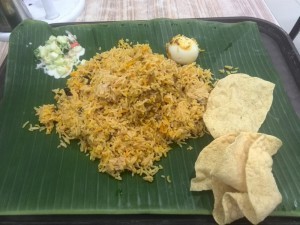
Chicken Briyani
Amazing Singapore Foods #2 PopeyesCost: $7SGD
Popeye’s is a US southern style fried chicken fast food joint. I include it for 2 reasons:
1. It shows that western fast food is plentiful in Singapore.
2. ‘Cause I’ve always wanted to go to Popeye’s but for some reason or another just never have
I wasn’t happy with it. It was basically just a slightly better version of KFC, which doesn’t say much since KFC is my least favorite Fast Food, and I’m not a massive fan of fast food in generaly. Fries are good though and I hear the potato gravy is good too.
I also discovered Long Johns Silvers here, another American fast food chain I’ve never tried, and that I am almost 100% sure I’ll live to regret it.
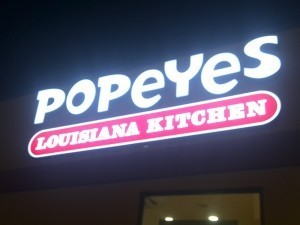
The only place out of America I’ve seen Popeye’s as well as Long John Silvers
Amazing Singapore Foods #3. Haianese ChickenCost: $7SGD
I actually preferred this to the Hainese Chicken I had in Hainan. This place was located right next door to the toy msueum#8 of the top things to do in Singapore.
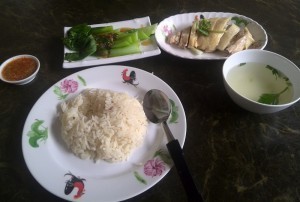
Better Hainanese Chicken than what I had in Hainan
Amazing Singapore Foods #4. Ice-creamCost: $1.20SGD
A solid block of ice-cream sandwiched between 2 wafers. Comes in a variety of flavors including Red Bean and Durian which are acquired tastes (Durian in particular) that are worth a try. $1.20SGP on the Esplanade bridge or only $1SGP around Bugis Square (#8 of the Top Things to Do in Singapore).
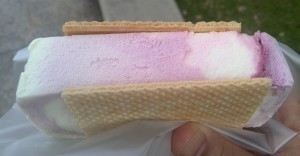
A block of blueberry ice-cream in some wafer crackers
Amazing Singapore Foods #5. Bee HoonCost: $3SGP
I found this in and Indian restaurant. I thought it would be pretty similar to Mee Hoon (thin rice noodles) and it was… but pink.
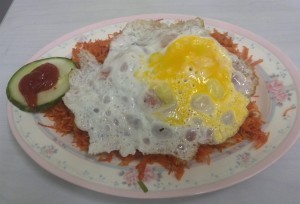
There’s pink rice noodles under the egg
Amazing Singapore Foods #6. Masala DosaiCost: $3SGD
Dosai is basically a pancake type ‘bread’ rolled around some type of filling. This one had some type of potato mixture inside. There’s many different types to choose from, prices varying depending on whats inside.
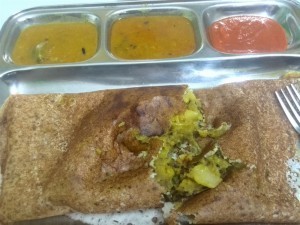
Masla Dosai. There’s many different types/flavors of Dosai
Amazing Singapore Foods #7. Nasi Ayam PenyetA type of chicken (fried) rice, which is also available in Ikan (fish). It was a really good meal and only 4SGP from Changgi Village, near the bumboat to Pulau Ubin (#17 of the top things to do in Singapore).
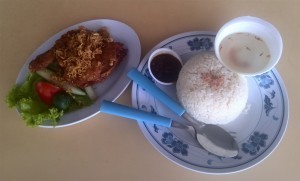
A style of chicken rice, apparently famous in Singapore. Simple and delicious.
Amazing Singapore Foods #8. LaksaCost: $5-$7SGD
I’ve had Laksa in Malaysia but saw this one restaurant on a travel show that is famous for it so I went to check it out. I don’t think it was any better than I’ve had, but it was still delicious, and that is saying something because it is a seafood dish and I am not a fan of seafood.
Basically it is noodles and seafood in a coconut type curry soup. The restaurant is called 328 Katong Laksa and can be found at 49 East Coast Rd, on the corner of Ceylon Rd.
From bus stop 2 at Tanah Merah take bus #12 to the Roxy Square stop.
A large is 7SGP and a small is 5SGP. The thing they offer you with it is fish, which I did not get.
There’s a picture of the owners (I guess) with Gordon Ramsey on the wall.
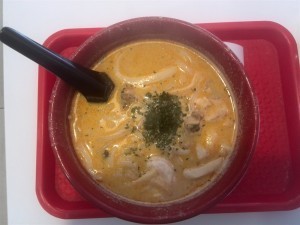
Laksa. Noodles and seafood in a coconut curry type soup
Amazing Singapore Foods #9. Frog PorridgeCost: Probably about $6SGD
I didn’t try this but it seems to be famous in Geylang.

Frog Porridge. I didn’t try it, but wish I had now.
Amazing Singapore Foods #10. Kaya ButterCost: Probably just a couple of SGD
Kaya butter is a sweet coconut and egg mixed spread. Use it like jam. I ate it in a sandwich for breakfast every day, sometimes with peanut butter.
Lots of places well it on toast for a few SGD.
Amazing Singapore Foods #11. Mee SiamCost: $4.50SGD
Thin rice noodles in a sweet/mildly spicy tomato type broth with prawns and a hard boiled egg.
I think it would have been much better from a proper restaurant but was still not too bad from the cafe at the MacRitchie Reservoir (#20 of the top things to do in Singapore).
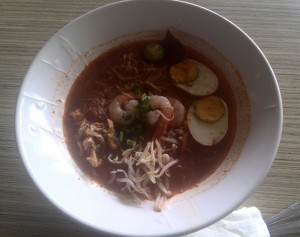
Mee Siam
Amazing Singapore Foods #12. Bak Kut TehCost: $6SGD (Includes You Tiao)
Bak Kut Teh is pork soup. Slow cooked I guess because it falls of the bone. You Tiao is friendship bread… it’s what they eat in IP Man: A legend is born.
It came with a chilli and sweet soy sauce. I take back what I said about Chinese chilli (#1).. this stuff knocked my socks off.
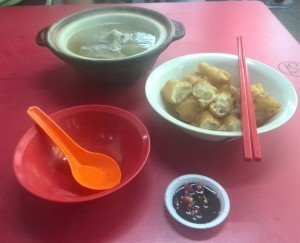
Slow cooked pork bone soup
Amazing Singapore Foods #13. PorridgeCost: $4SGD including You Tiao
Cantonese style porridge of different ‘flavors’. I’ve been living in the Canton area of China for the past couple of years (Guangdong) so I’ve had this before. None the less, the prridge is very good and can be had plain, shredded chicken, egg etc.
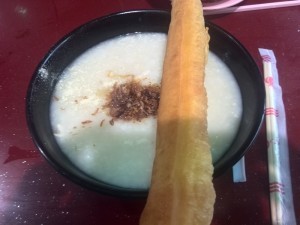
Shredded chicken Canton style porridge with You Tiao (friendship bread)
Amazing Singapore Foods #14. Pie FaceCost: $3-$6SGD depending on size and flavor
Next to Long John Silvers near Bugis Station is a place called Pie Face. It is the closest thing to Australian meant pies I have come across outside Australia, except for in England. For those of you who are familiar, they are pretty much Jesters Jaffle Pies, and I think I saw a sign saying they are Australian owned so maybe it is the same company.
You can get mini or normal size in a variety of flavors, and you can even put mash potato and mushy peas on top for an extra $2SGD.
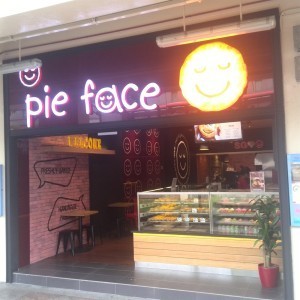
Closest thing to an Aussie Meat Pie I’ve had outside Australia or the UK
Amazing Singapore Foods #15. Economy RiceCost: $2.50
The last thing on my list of amazing foods of Singapore is Economy Rice. Actually, it was only $2.30SGP for rice, 1 meat and 1 veg.
This was Chinese, but Indian places also do it. Of course you are not limited to 1 meat, but the price go slightly up for every extra serve.
I also had a TsingTao beer for $6SGP. I’m not sure why I had Tsing Tao. I should have tried something Singaporean. Habits from China I guess.
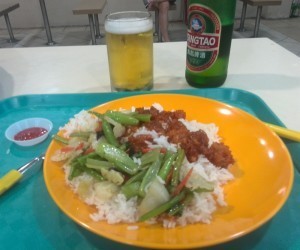
Economy Rice. Very edible meals at only $2SGP, with rice, 1 meat and 1 veg.
Nothing really stood out as a favorite of the amazing foods of Singapore, but they were all good.
Well that’s it. I hope you have enjoyed my list of amazing foods of Singapore. What foods have you tried from Singapore?



The post 15 Amazing Singapore Foods appeared first on Survive Travel.
December 23, 2014
How to Make a Survival Keychain
Learn how to make a survival keychain. There is no one way to make a survival keychain. What you put on it depends on your personal needs and wants.
Why Make A Survival Keychain?There’s many methods and schools of thought about survival kits. The problem with most survival kits is that they are too big to carry around in everyday life. Even a survival keychain can become too cumbersome if you get carried away and put too much stuff on it.
The reason for making a survival keychain and not a survival kit (or mini-kit) is so that you WILL carry it EVERYWHERE, just in case SHTF (Shit Hits The Fan).
How to Make a Survival KeychainWhen you make a survival keychain, minimalism is the ‘key’, so to speak. There more stuff you put on it, the bulkier it becomes, and the less likely you are to carry it. There’s no use put putting all this stuff on it if you’re not going to carry it.
Ultimately, what you put on your survival keychain is up to you and what you can get your hands on e.g. If you do a lot of air travel, then a knife is not a good idea. If you have big pockets and don’t mind carrying more, than you can put more on it.
Using my survival keychain as an example, it can give you some ideas for what to put on yours when you make a survival keychain.
CompassA compass is an an essential survival tool. Learn how to use it. Watch out because some of the smaller ones are inaccurate.
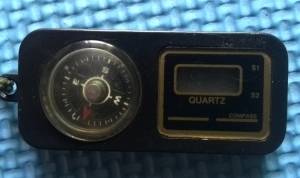
The compass is a invaluable survival tool
WhistleA small, loud whistle can be used to attract attention for rescue, if attacked on the street and perhaps to scare away animals.
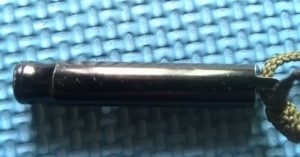
Keyring whistle. Get a loud one without a pea.
Para CordParacord is extremly useful. Repairs, shelter building, fishing, cutting etc. Proper paracord is strong enough to hold a human if you need to climb down it! Inside is 7 strands that can be used for fishing, sewing etc. There’s so many uses and plenty of other people have blogged about them.
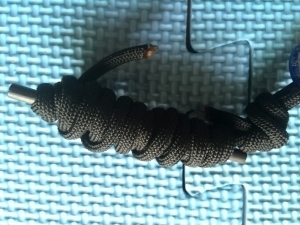
This paracord is wrapped around the magnesium stick, which disguses it from the TSA and enables it to be attached to the key-ring.
Magnesium StickWhen struck it creates a spark to make fire. It can be difficult if you’ve never done it before, so learn how to use it before you need to. Fire is extremely useful in a survival situation.
I can’t seem to find where to buy just the magnesium stick by itself, but just buy the normal one and take the stick out, then wrap it with your paracord so it can be attached to your keyring.
Mini FlashlightI currently do not have this on my survival keyring, but only because I lost it recently. Also, everything else on my survival keyring is waterproof, but I havn’t yet come across a small keyring flashlight that is waterproof (although I know they are out there, I think Bear Grylls produces one).
Never the less, a flashlight is pretty handy.
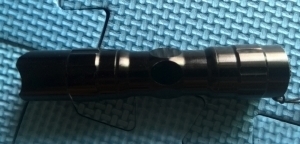
This is not a mini flashlight as recommended, but is waterproof and small enough to carry separately in my pocket.
Flash DriveThat’s right, in a modern world, you can store all your information digitaly and you never have to be without it. It isn’t essential for survival, and possibly useless in a WSHTF (When Shit Hits The Fan) scenario, but extremely useful in everyday life. The one on my survival keychain is waterproof and scratch resistant (by Lacie).
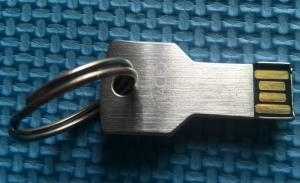
This 16gb zip drive made by Lacie is waterproof and scratch resistant.
Mini Multi-ToolA multi-tool can be extremely handy thing to add when you make a survival keychain, but most of them are too big. An option is to get a Mini-Tool. there are loads to choose from, do your research. They are not as useful as a standard size multi-tool, but in situations where there’s nothing else available it comes in handy.
The one I use is a Swiss Tech Micro.
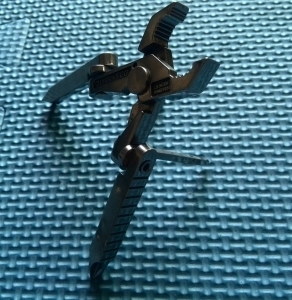
Mini Multi Tool. The SwissTech Micro
Keychain Lock Pick SetThe last thing I recommend on your survival keyring is a lock pick set. I researched a good one at IdealCreations.net but I do not have it on my keyring. I still use a small set I have had for years, and just keep it in my travel wallet.
Obviously, you need to learn how to pick locks for it to be of any use, which isn’t really that hard but takes some practice.
Getting Your Survival Keychain Through CustomsIf you have any type of blade on your survival keyring it will not get through. I carry a blade seperate and put it under the plane, or if I am just with carry-on, which is quite often, then I just buy a blade first thing in the new place.
Sometimes the magnesium stick can give you problems. If you just put it in your bag, it will often get overlooked. If you put it seperate so it is visible, you are more likely of getting ‘harrased’. The US has the ‘worst’ customs, meaning they are quite strict.
I’ve never had any problems with the minitool because the one I use has no blade.
Nor have I ever been stopped for the lock pick set either, but I don’t have mine as part of my survival keyring.
Well that’s it for this post on how to make your own survival keyring. Ironicaly, I don’t have any keys on it.
What have you got on yours?



The post How to Make a Survival Keychain appeared first on Survive Travel.
How to Make an Airplane Safe Survival Kit
This post details how to make an airplane safe survival kit. Having to omit dangerous goods such as sharps means this is inferior to most survival kits. At the very least, buy a knife and a lighter ASAP when you land.
How to Make an Airplane Safe Survival KitThis airplane safe survival kit also includes a medical kit, but does not include the survival keyring.
Every item in your airplane safe survival kit (or any survival kit) should have at least 2 purposes… and they can have many more with a little improvisation.
Airplane Safe Survival Kit ContentsAs with all survival kits, what you put in yours should adapt to your lifestyle. If I didn’t need it to be an airplane safe survival kit I would most certainly add more fire starting items and a good knife.
Mess KitThis is a container to put everything in. It should be waterproof and the ability to at least boil water in it. Aluminium is good and light, and it helps if it has a handle. The one I use, and it is perfect, is the Trangia Mess Tin.
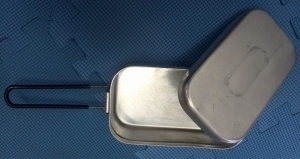
The Trangia Mess Tin is ideal
US DollarsUS dollars are the most widely accepted currency all over the world. I keep 2 $20 bills, since some countries will not accept over $20 bills. I also have an all-purpose emergency credit card in there.
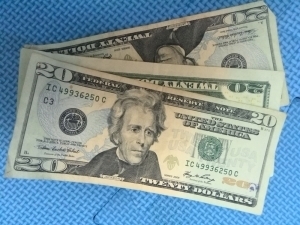
American Dollars are the most widely accepted currency in the world. Denominations of 20 or less are best.
PaperRecording any information you gather is vital in a survival situation. I advise to carry a notebook and pen/pencil in your day pack, but also carry some paper in your airplane safe just in case. Paper can also be used to start fires.
If traveling it is a good idea to have copies of your passport credit cards. You can use these photocopies as the paper in your survival card.
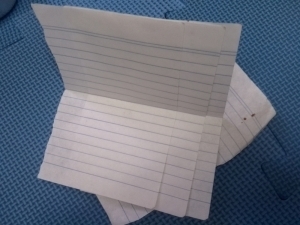
Paper for tinder, taking notes etc.
PencilA pencil is more reliable than a pen which could leak and run out. The pencil can also be shaved to use as tinder.
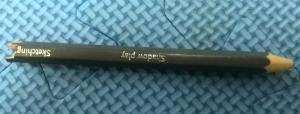
Also good for note-taking and tinder. Crush the graphite and use it to lubricate stubborn locks.
ParaCordParacord is extremely strong and can be used in a multitude of ways. As one, it is strong enough to hold a person. Inside, it is made up of several smaller strings which can be used as sewing thread, fishing line etc.
You can also use para cord to cut things, depending on what you are trying to cut. Shelter building, general repairs etc.
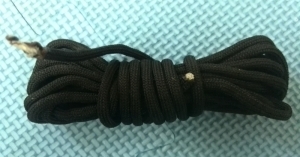
Paracord is extremely strong and useful
CompassA good quality compass is invaluable as a survival tool. Learn to use it properly. Sivla are Suunto are well known for quality compasses.
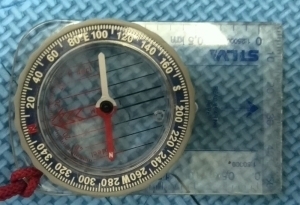
A high quality compass ins invaluable in a survival situation. Make sure you learn how to use it.
CondomApart from the obvious reason, a condom can also be used to carry water, as a waterproof container, to tie things etc.
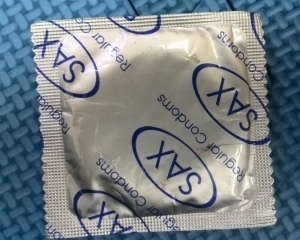
Condoms come in handy because liquid can’t get in or out of them.
Gaffa TapeGaffa Tape has an abundance of uses including medical uses, and is only limited to your imagination.
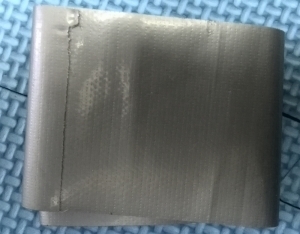
Gaffa Tape aka Duct Tape.
Glucose TabletsSugar. Your body needs it to survive.
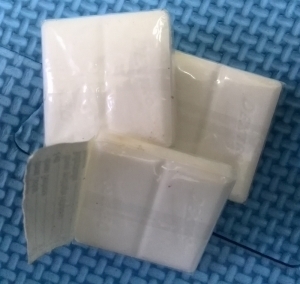
Glucose tablets. Any sugar will do the same thing e.g. jellybeans, chocolate bar etc.
Stock CubesSalt. Your body needs it. Mixed with some hot water, a makeshift soup can be a real moral booster.
Note: In the ‘real world’ too much sugar, salt and/or fat is considered bad. In a survival situation those are the 3 things your body needs most. Also, a sugar cube and stock cube may not seem like much but as long as you have water, your body can survive about 3 weeks without food. If it comes down to it, a little sugar and salt can go a long way.
Water Purifying TabletsMaybe water purification tablets only have one use, but it’s a good one. Read the directions.
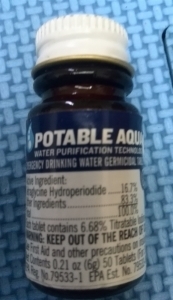
Water Purification Tablets. Use as directed.
FREDFRED stands for Field Ready Eating Device, or Fucking Ridiculous Eating Device. Despite the nickname, it is actually very handy. It’s a bottle opener, can opener, box cutter and spoon in one compact device.
Pick one up at any outdoors store or online for a couple of bucks.
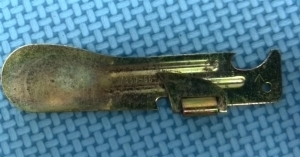
Field Ready Eating Device aka F*cking Ridiculous Eating Device.
Note: Although I’ve never had a problem with it before, this item got taken off me in Australian customs so it is no longer part of my kit. I figure if I really need to open a can any knife will do,and failing that, a rock.
Super GlueCan help to start a fire (is really flammable), as well as being awesome for repairs. If taking it on a plane, I put this with my toothpaste in the clear zip lock bag.
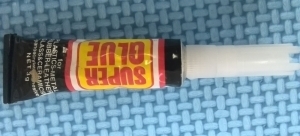
Super Glue. Don’t forget to put it in your liquids back when going through security at the airport.
Sewing NeedleGood for sewing (obviously) and can also be used as a fishing hook if crafted well. Have one or 2 strong sewing needles. The job might not be pretty, but in a survival situation, a strong one can do more than a little one.
Use fishing line or dental floss as thread.
I guess it is possible that TSA will take the sewing needle of you, but I’ve never had a problem.
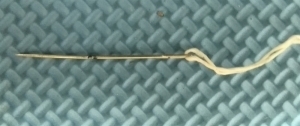
A sewing needle with dental floss as thread.
Fishing LineUsed for fishing, as sewing thread, tying stuff etc. Like the sewing needle, stronger can do more stuff.
Rubber BandsI use these more than expected. They are very handy.
High Vis Velcro StrapI found this item whilst riding to work in Newcastle. I think its actually purpose is for bike riders, to put around their leg so cars can see them easier at night. I wrap I around my air travel safe survival kit to help keep it closed. I’ve never used it in any other way, but I’m sure it will be invaluable if I ever need to be rescued.
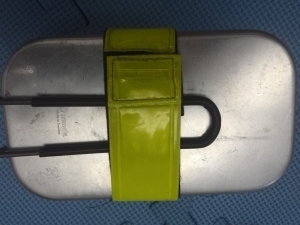
My hi-vis Velcro strap wrapped around my airplane safe survival kit.
These next two items I don’t actually keep inside my airplane safe survival kit, but they go in my day pack and I count them survival items.
PonchoA good poncho is extremely under-rated. I use mine frequently in times of sudden downpour, and even take it hiking instead of my North Face Jacket sometimes.
In my opinion, they are better than your Gortex rain jacket. They don’t keep you warm, but just put a jumper on underneath it! You can get emergency ponchos to fit inside your kit but a large, strong poncho can also be improvised into a shelter or groundsheet if needed.
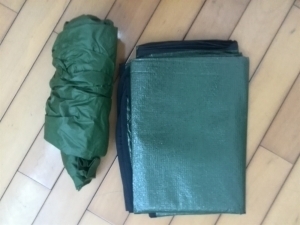
My Poncho and Survival Ground sheet all packet up is MUCH smaller than a raincoat, tent or sleeping bag, and does the same job.
Casualty BlanketLike the Poncho, you can get really small emergency ones of these to fit in your survival kit. I like to carry a ‘heavy duty’ one, which fits nicely into my daypack. It’s a groundsheet, shelter, blanket etc. The difference between this and the poncho is that this has that foil reflective quality which will keep in your body heat, and can also be a very effective signaling device.
I do not carry a tent or sleeping bag. Granted, if I go on any hike where I would need these things, I’ll hire them, but for the most part, if I have a Poncho coupled with a heavy duty survival blanket, I can make a pretty good improvised shelter and will not freeze to death.
Having a ‘heavy duty’ survival blanket and poncho may be bigger than the emergency ones, but they are much lighter than a tent or sleeping bag or rain jacket, and do the same job as all three.
Obviously if I plan on going for a serious hike I would consider hiring some more appropriate gear, but I have used just these for one or two nights emergency camping and it wasn’t too bad.
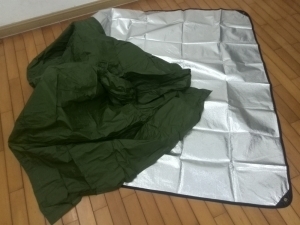
My Poncho and Survival Blanket. No need for a tent or sleeping bag if I have these two things.
Airplane Safe Medical KitMy airplane safe medical kit is kept in a zip lock bag, and then coupled with the airplane safe survival kit inside a dry sack. The dry sack makes sure everything stays super dry, and also allows me to clip it to my belt if I decide it is all I want to take on a short hike or something, although I have never actually done that.
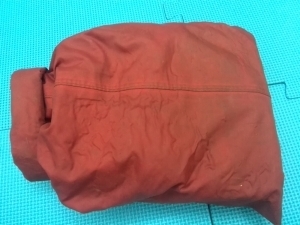
Inside this dry sack includes the survival kits and medical kit.
The contents of you medical should reflect your knowledge. There’s no point having a stethoscope if you do not know how to use it.
Assorted Band AidsAn assortment of sizes is useful. Remember that large ones can be cut down, but small ones cannot be enlarged. They can also be cut into butterfly sutures if needed.
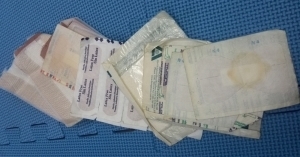
An assortment of band aid. Different sizes and shapes.
TweezersPick out splinters, debris in wounds etc.
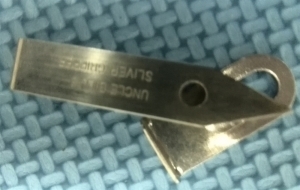
Tick tweezers are small to carry and not just for ticks.
Magnifying GlassYou can get mini magnifying glasses, I wouldn’t stock a big one. Other than seeing ticks and other small things, it can be used to start a fire.
A tick removal kit is cheap and comes with mini tweezers and magnifying glass.
Assorted PillsI keep these in a tobacco tin. What you put in it is up to you. I have drugs for diarrhea (Imodium), constipation, travel sickness, antihistamine and pain relievers (ibuprofen).
If you can get your hands on it I also include some higher grade behind the counter pain relievers and a course of anti-biotics. You doctor will usually give you a prescription for these things if you explain to him/her that you are going traveling/hiking for an extended period of time.
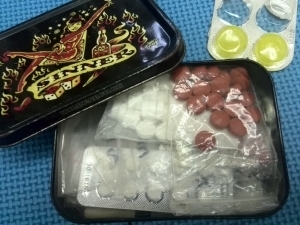
My assortment of pills. Nothing illegal of course. Mostly over the counter drugs.
Mini ScissorsThese sometimes get taken by the TSA, but they are cheap and readily available. Very useful even for non medical needs.
Tip: Sewing needles, safety pins and other things that have a small chance of getting stopped by customs, I keep together and separated for easy access at customs so I can show them all easily without having to dig through my luggage.
Vet WrapVet wrap is like a roller bandage that sticks to itself. It is great stuff, purpose built for animals, mainly horses I think. It can be used for all sorts of things.
Cotton BudsUseful for cleaning wounds etc.
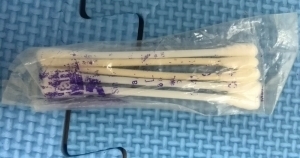
Not recommended to clean your ears, but great for wound cleaning.
I put these following slaves/creams in my toiletries when scanning through the TSA.
Surgical GlovesSurgical Gloves are extremely important for preventing infection. They can also be used as a waterproof container, or even to transport water (since it is waterproof).
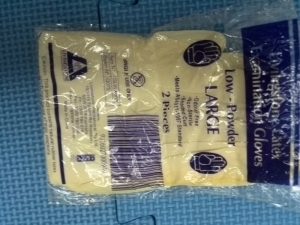
Surgical gloves are imperative to prevent infection.
Tissue PaperToilet/tissue paper is immensely handy and you should keep it in multiple places. Toilet paper, tissue paper, starting fires, write on it, clean stuff in general etc.
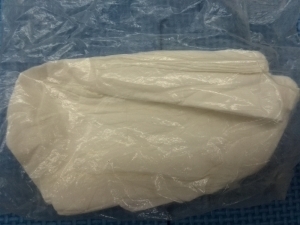
I know you know what toilet paper looks like
Hand SanitizerThis is handy for general hygiene before eating or touching anything questionable. It’s also flammable if you need help starting a fire. Could probably also be used as antiseptic if needed.
Lip BalmThere’s nothing worse than chapped lips. Well, actually, there’s lots of things worse, but if it can be avoided, why not.
SavlonAntiseptic cream
SunscreenTo protect your skin from getting burnt (obviously)
Itch Relief CreamAny topical numbing agent, also works for minor burns, rashes etc. Diphenhydramine is common.
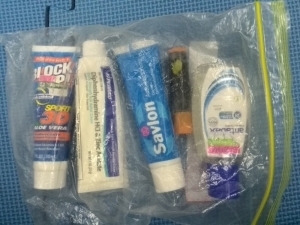
All my liquids, airplane ready. I’d also put my toothpaste, moisturizing cream, mouthwash and super glue. Yes, it all fits.
Things I’d AddIf getting through customs isn’t a concern, and especially if I intend on ‘going bush’, I add the following things.
KnifeNothing beats a good knife in a survival situation. Two or more is even better.
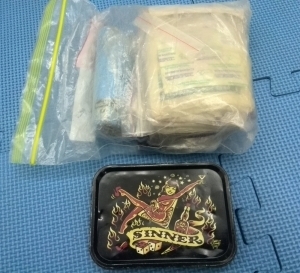
My complete medical kit.
MultiToolI have a Leatherman Skeletool, but there are loads of options depending on your needs.
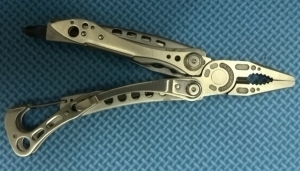
Skeletool. Unfortunately not Airplane safe, but one of the best things I leave behind.
Lighter, Matches etcLots of fire starting stuff, including fuel tablets. Actually, I have fuel tablets in the TSA safe kit and I’ve never had them taken off me, but they should be.
Fishing HooksFishing hooks and some sinkers etc.
Well that’s it for this post on how to make an airplane safe survival kit. Remember though, no matter what you put in yours, the best survival tool is your mind. You can check out…
What do you put in your airplane safe survival kit?



The post How to Make an Airplane Safe Survival Kit appeared first on Survive Travel.
November 29, 2014
7 Top Foods of Macau, China
Discover 7 top foods of Macau, China. Originally I thought Macau would just be full of Cantonese food, and it is, but it also has it’s own little spin of things which I assume is somewhat due to its Portuguese heritage (among other things).
In any case, the food of Macau is delicious. Here are some of my top recommendations of must try foods of Macau.
7 Top Foods of Macau, ChinaOK, here they are. 7 Top foods of Macau, China.
1. Braised Beef Curry Noodle SoupThe first item on my list of top foods of Macau is not something I had heard about. It just happened to be the first thing I ate after crossing the border from Zhuhai. It is Braised Beef Curry Noodle Soup. It was extremely tasty and cost just under 20 Mop from some place near the bus station at the Zhuhai border crossing. Actually, this was my favorite of my top foods of Macau.
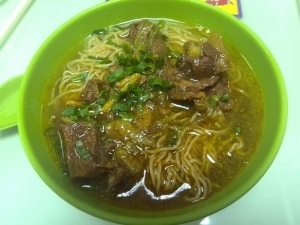
Braised Beef Curry Noodle Soup. The first thing I ate in Macau… it was a very good start!
2. Egg TartsMacau Egg Tarts are world famous. In the village of Coloane you can go to the place where the very first Macau Egg Tart was invented. They also sell pretty good sandwiches.
Of course, the egg tarts can be bought all over Macau for 8 or 9 MOP a piece. I’m not a big fan of Egg Tarts, but thats because I hadn’t had the proper ones made in Macau. These are definitely a must try.
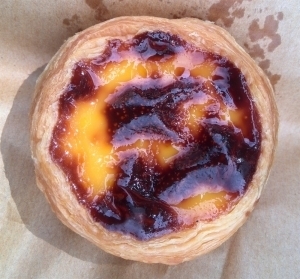
World Famous Macau Egg Tarts
3. Macau Pork BurgerThe Macau Pork burger can also be found all over Macau. Near the St Paul’s Cathedral Ruin’s you can get a plain Macau Pork Burger and Egg Tart combination for 30 MOP. It’s pretty good, but if you want a really good one, try some of the different flavors from other vendors. I got a really good one from the cafe in Macau Tower and it was about the same price.
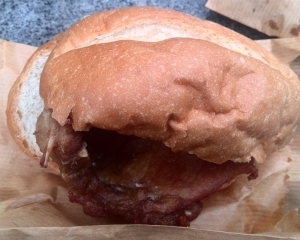
Pork in Bread. Simple and delicious.
Tip: To find the best accommodation, compare Hostelbookers.com and HotelTravel.com and to find the cheapest flights use CheapOair.com
4. Coconut Chicken RiceNot much to say about this. It was coconut chicken, and it was delicious.
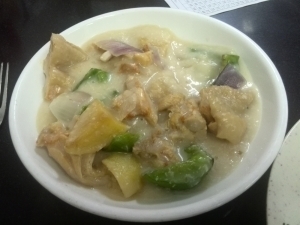
Coconut Chicken. Comes with rice. Tastes about a billion times better than it looks.
5. J-StickI think this might actually be Korean, but there’s a little shop around the corner from the St Paul’s Cathedral Ruins (walk to the bottom of the stairs and turn right on that street. Shop is on your left.)
This thing is just filled with ice-cream. Costs 30MOP and is worth every cent. After a Pork Burger, egg tart and one of these I was full for a while.
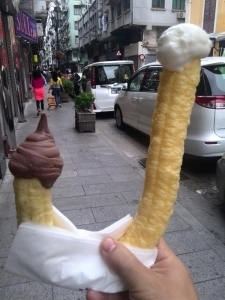
J-Stick. A kind of hollow cone filled with vanilla and chocolate soft serve ice cream.
6. JerkyI’m not sure if it is technically jerky, but it is definitely dried meat (pork I think) and there are so many flavors. Near Senoda Square there is a street where many vendors will give out free samples. I have tried this before and didn’t like it, but the samples they give are fresh and amazing.
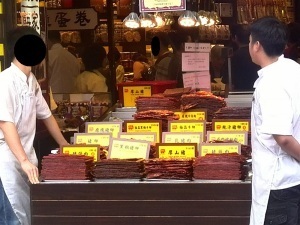
Dried meat in a bunch of flavors. You can have your fill in free samples from all the vendors.
7. Almond CookiesThe last thing on my list of top foods of Macau are Almond Cookie. On the same street as the Jerky, there are many vendors with free samples of these Almond Cookies which are considered a specialty of Macau. They are really good.
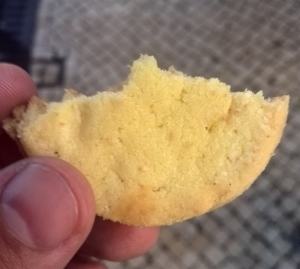
Almond Cookies… A Macau Specialty.
Well that’s it. I hope you have enjoyed my list of 7 top foods of Macau and please feel free to add more things in the comments.
Tip: To find the best accommodation, compare Hostelbookers.com and HotelTravel.com and to find the cheapest flights use CheapOair.comThe post 7 Top Foods of Macau, China appeared first on Survive Travel.
9 Interesting Things to Do in Macau, China
Discover 9 of the most interesting things to do in Macau. Also includes cheap accommodation, directions in and around Macau and lots of other useful information on how to survive travel in Macau, China.
9 Interesting Things to Do in MacauOk, here it is. My list of 9 interesting things to do in Macau, China.
1. Senado SquareThe first thing on my list of interesting things to do in Macau is to go to Senado Square. It’s just cool to walk around and there’s a good street in there somewhere where you can sample Macau’s famous almond cookies and jerky.
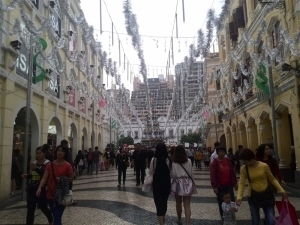
Walking around Senoda Square
Getting to Senado SquareBus 3 or 5 from the ZhuHai border crossing bus station will get you there, and there are others also from other places e.g. the number 10.
2. Hac Sa Beach aka Black Sand BeachHac Sa Beach is supposedly one of the best beaches in Macau. I wanted to check it out because I thought seeing a beach just full of black sand would be cool, and it would have, but the beach is not full of black sand. Still nice to go and see though.

Hac Sa Beach. No Black Sand but nice none-the-less
Getting to Hac Sa BeachBus number 25 will take you there. There are others. It is the last stop so just look for Hac Sa. Bus fare is 6.25MOP. It’s about a 40 minute bus ride.
3. Villa De ColoaneVilla De Coloane is a quaint little village with a few different things to see including some temples, church, library etc. Nice Portuguese architecture.
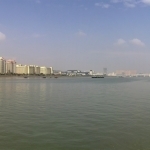
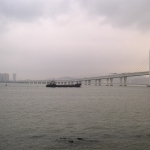 Getting to Villa De Coloane
Getting to Villa De ColoaneCatch the 25 bus (or others) to stop Villa De Coloane. We accidentally got off one stop too far from Hac Sa beach and ended up outside the local jails.
4. Egg Tarts from Lord Stow’s BakeryOk, so Lord Stow’s Bakery is also in Villa De Coloane but I felt it deserved its own number. This is the actual shop that Macau Egg Tarts were invented in! I’m not a huge fan of egg tarts, but these are delicious. They sell good sandwiches too.
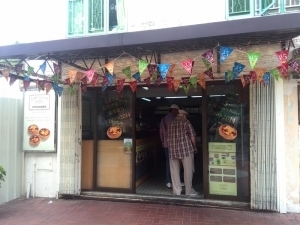
Lord Stows Bakery. This is where Macaus world famous egg tart first started!
5. CasinosOne of the big things Macau is known for are the casinos and you could spend a good chunk of time checking them all out. Personally I think the ones in Vegas are better, but the ones in Macau are still very impressive.
One big difference I did notice. No Craps tables and lots of Baccarat.
Three things I feel deserve a special note are;
1. The Venetian shopping area. Roof painted to resemble the sky and a canal running through it with gondola rides on offer. Actually, I wouldn’t be surprised if it is the exact (or very close) to the same design/layout as the one in Vegas.
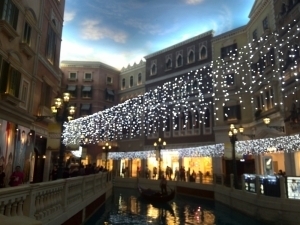
Inside the Venician
2. The fountain show outside the Wynn. Every 15 minutes during certain hours of the day.. I think like from 12-9 pm… but I can’t be certain. In any case, it is a good 2-3 minute show.
3.Cool tropical aquarium in the MGM grand. Also what I think had the best gaming area of the casinos I went to.
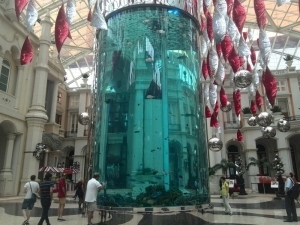
Inside the MGM Grand
Getting to CasinosObviously it depends on which ones you want to go to. Many of them have free shuttle buses to/from the borders and ferry terminals. Some are walking distance from the city (Wynn, MGM Grand etc), and others are on Taipa, which is a bus ride away. The #25 among others will land you outside the Venetian/Sands Casinos.
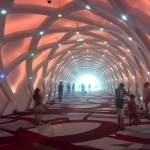
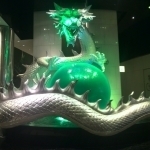 6. Macau Tower
6. Macau TowerThe iconic Macau Tower boasts being the highest bungee jump in the world! Even if you’re not keen to Bungee, it’s worth the look. Nice cafe inside where you can get a pretty good Macau Burger, which I felt was much nicer than the ones on ‘the street’.
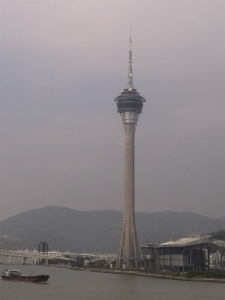
Macau Tower boasts being the biggest Bungee jump in the world!
Getting to Macau TowerThe 9a bus will get you there from town. 3.25MOP.
7. Mount FortressThis was my favorite of my interesting things to do in Macau. Walk up to the Fortress and take a look around. It has some nice views of Macau. Free Entry. Also has the Macau Museum which I did not check out.
Tip: To find the best accommodation, compare Hostelbookers.com and HotelTravel.com and to find the cheapest flights use CheapOair.com
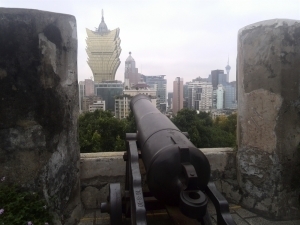
View from the Mount Fortress
Getting to the Mount FortressIt is walk-able from town. Just follow the signs which are all around the town center.
8. Ruins of St. Paul’s CathedralThe Ruins of St. Paul’s Cathedral is probably one of the most photographed things in Macau and is definitely worth a look. You can also go into the Crypt and see some sacred art of Jesus type stuff. Everything is free.
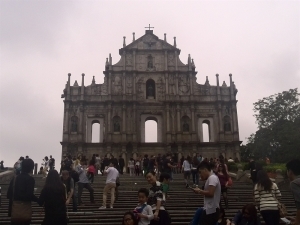
ruins of St Paul Cathedral. Probably the most photographed spot in Macau
At the bottom of the stairs you can get a Macau Burger and Egg Tart for 30MOP, and around the corner to the right you can try a J-Stick filled with ice-cream. Also 30MOP.
Getting to the Ruins of St Paul’s CathedralIt is very close to the Mount Fortress. Follow the sign you see as you walk about town.
9. Red MarketThe last thing on my list of interesting things to do in Macau is to go to the Red Market. Unfortunately I didn’t end up going inside, but it looked good.
Getting to the Red MarketIt can be found on the corner of Avenida Horta e Costs and Almirante Lacerda.
Other Useful Information About Macau, ChinaHere’s some other useful information about surviving travel in Macau.
Getting From Mainland China to MacauGetting from Mainland China to Macau is fairly easy. Other than catching a plane, the easiest way is to cross the border in Zhuhai.
Zhuhai is connected to Guangzhou by fast train, so first get yourself to Guangzhou. I live in Shunde, which is along this train line and from there the ticket to Zhuhai (one way) cost 55rmb. From Guangzhou to Shunde costs 20rmb, so you can do the math. There are many trains every day, but consider booking ahead as just arriving to catch the next one is often sold out.
The journey takes approximately 45 minutes. Make sure you go all the way to Zhuhai. Do not get off at Zhuhai Bei.
Once at the Zhuhai train station walk out of the train station and turn right. Keep walking until you get to the departure hall. Check out of China, then into Zhuhai.
Visa Information for MacauMany countries can enter visa free from 2 weeks to 3 months depending on what countries passport you hold. Others can easily get a visa on entry. A handful of countries must apply in advance. Being Australian, I was allowed 30 days visa free. Check TravelChinaGuide.com/embassy/visa/macau.htm for details.
Getting From the Border to Macau City CenterYou can catch one of the many free shuttle buses to the casino of your choice, or the number 5 from the bus station will take you to Senoda Square.
Cheap Accommodation in MacauIf you need cheap accommodation in Macau, I stayed at the Holiday Hotel.
Macau is definitely not backpacker friendly and there are next to no hostels. The Holiday Hotel was the cheapest hotel I could find, and I had low expectations but I was happy with it. Room came equipped with TV, air-con, shower, twin beds etc. Cost was 70usd per night for the room, which housed 2 people. Location was decent also. Close enough to the city.
Getting to the Holiday Hotel, MacauTo get to the Holiday Hotel from the Zhuhai Border crossing, simply walk out the immigration building, past all the Casino shuttles and down the stairs to the bus station.
Catch the number 5 to the city, then walk or catch the number 7, 7a or 8 to the Holiday Hotel. Get off at the McDonald’s near the roundabout. The hotel is on the street across from the McDonald’s.
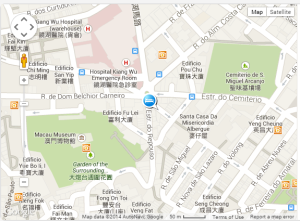
Map of area around Holiday Hotel Macau
Getting Around MacauThe bus system in Macau is pretty good. Unless you have one of those transport cards, they only accept exact change, but don’t worry if you don’t cause the drivers don’t keep a good eye on it and I figure it all balances out anyway e.g. if the fare is 3.2 you will may either have 3 or 4, it won’t matter.
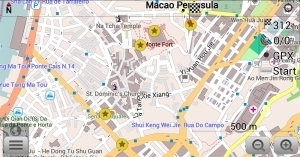
Map from OSM Maps of stuff around Macau city centre. From top to bottom – Holiday Hotel – Fort – Ruins – Senado Square – City Center towards the Casinos
Money in MacauMost places in Macau accept 1:1:1 on MOP/HKD /RMB, but MOP is worth the least and RMB is worth the most. HKD is not far off the MOP. MOP is pretty much useless outside Macau. Most casinos only accept HKD.
Well that’s it. I hope you have enjoyed my list of 9 interesting things to do in Macau, China and please feel free to add more things in the comments.
Tip: To find the best accommodation, compare Hostelbookers.com and HotelTravel.com and to find the cheapest flights use CheapOair.comThe post 9 Interesting Things to Do in Macau, China appeared first on Survive Travel.
October 15, 2014
How to Read a Chinese Bus Ticket or Train Ticket
Tip: To find the best accommodation, compare Hostelbookers.com and HotelTravel.com and to find the cheapest flights use CheapOair.com
This post will help you read a Chinese bus ticket or train ticket. I didn’t put a very wordy explanation, because the pictures are labeled and pretty self explanatory.
How to Read a Chinese Bus Ticket
Note: The seat number may or may not be enforced
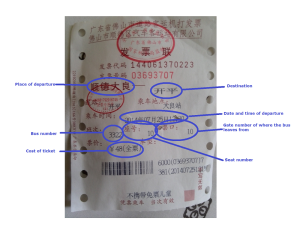
Chinese Bus Ticket. Click to enlarge the photo.
How to Read a Chinese Train Ticket
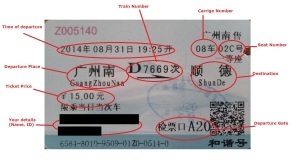
A Chinese Train Ticket. Click to enlarge the picture.
Note: The seat numbers on a Chinese train ticket are usually enforced i.e. people respect them. There may be someone sitting in your seat, just ask them to move.
Ni Hao, wo de zuo. (Hello, my seat). It’s very simple Chinese but they understand. Maybe show them your ticket at the same time.
Get the Latest Survive Travel Books FREE! Click Here to Get Them.A lot of people only have standing tickets on trains, so if there is a spare seat they will just sit in it.
Buying a Chinese Bus Ticket, or Train Ticket
Whenever I buy a train or bus ticket in China I write down what I want in Chinese (or take a photo), show it at the ticket booth and hope they don’t ask questions.
I’ve had locals try to help me and mess it up. They start talking to the person, fuk knows what they talk about, but things get messed up along the way. If I have it written down, the person knows I can’t speak chinese, no questions so no details to mess up. Simple.
Also, if I am 100% that I’m going to use the ticket, I’ll buy it in advance, especially for long and/or infrequent journeys (infrequent being less than 3 a day). There’s lots of people in China, and a lot of them travel, it’s best to book ahead!
Well that’s all for this post. I hope it was helpful and you can now easily buy and read a Chinese bus ticket or train ticket.
Tip: To find the best accommodation, compare Hostelbookers.com and HotelTravel.com and to find the cheapest flights use CheapOair.com
The post How to Read a Chinese Bus Ticket or Train Ticket appeared first on Survive Travel.
October 4, 2014
9 Great Things to Do in Luoding, Guangdong, China
Tip: To find the best accommodation, compare Hostelbookers.com and HotelTravel.com and to find the cheapest flights use CheapOair.com
Discover 9 great things to do in Luoding, Guangdong. Also includes lots of other useful information on how to survive travel in Luoding, Guangdong.
China’s National Day gives us a week long holiday so I went to Luoding, Guangdong, China, to visit a friend whom I used to work with in Guangdong Ocean University.
9 Great Things to Do in Luoding, GuangdongOk, here it is. My list of 9 great things to do in Luoding, Guangdong, China.
1. Rent a MotorbikeThe first thing on my list of great things to do in Luoding, Guangdong is to rent a motorbike. Down the road from my friends place was a motor cycle rental shop, for 5RMB per hour. Not really a motorbike, more like a 50cc motorized scooter. Neither the speedometer or the fuel gauge worked. I put 5RMB of petrol in it and it got me around for a couple of hours with fuel to spare.
2. Go to the LakeThe whole purpose of getting the motorbike was to ride to the lake. It was a good 20 minute ride.
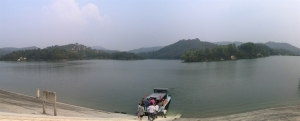
You can take a boat ride on the lake
The lake is really nice. It was a holiday so maybe there where more people there than usual, but it was still not that busy. There where a few people fishing, and you can take a boat ride for a nominal fee (we didn’t do it).
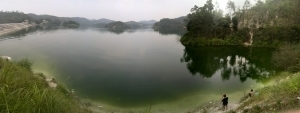
A picture of the lake with people fishing
3. Climb the HillAfter a quick look at the lake we rode the motorcycles up the hill. There were some really nice view points along the way, but the actual top of it was nothing special.
Actually, riding the bikes up this hill was my favorite of my great things to do in Luoding. Here’s a video of us riding up. It’s not great but I took it so here it is. The screeching is the wind, not the tires, the bikes don’t go that fast.
We saw others walking up it. which would take ages (think a few hours) and is just along the road). A bunch of kids rode up it on push-bikes also, but I don’t know if they made it to the top.
People drove their cars up, but they would get stuck because the road isn’t wide enough for two cars to pass each other. Motorbike is the best way to go up the hill.
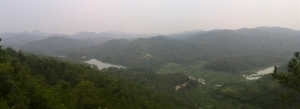
View from the mountain
4. Visit the SchoolsThe next morning we went for a nice walk around the town. My friend works at the college and it is next to the primary school. Walking around a school doesn’t sound great, but you can get up the buildings for some nice views, and there’s some interesting murals etc.
Get the Latest Survive Travel Books FREE! Click Here to Get Them.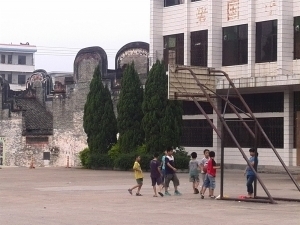
Kids playing at the primary school
5. Go to the TempleDespite the cultural revolution and anti religion government, there are still temples everywhere in China. This is one we stumbled upon. The architecture in temples is always interesting. They build them nice and strong, no nails or screws, just ‘fitted’ together.
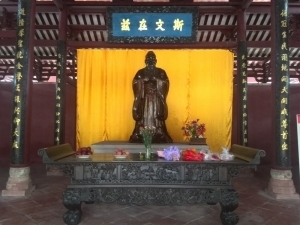
Kong Zi. The ‘person’ they worship at this temple.
6. See the TowerIn town there is this tower, overlooking this polluted/muddy river. I couldn’t help thinking that if the river was pristine as it would have been maybe even just a few decades ago, it would have been beautiful.
You can pay to go up the tower and get a view of the city. We didn’t bother so I don’t know how much it costs. Maybe 10RMB.
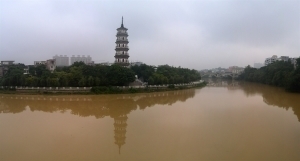
Tower in Luoding. Located in the town, overlooking this muddy/polluted river.
7. Walk through the HutongsLuoding is a nice town. Still has that old school China feel when you walk through the alleyways, but then you come out of the alleyway and you are in a bustling city.
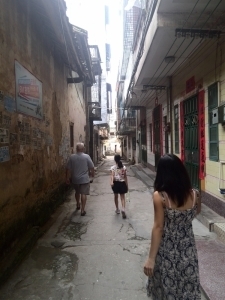
Walking through the alleys of Luoding
8. The MarketIn town there is the market. Apparently at night it turns into a clothes market. WWe were there during the day so it was all food. It’s about as fresh as you can get. Choose what you want, they’ll kill and wash it for you right then and there. Snakes, rabbits, birds, turtles etc. Seems cruel to see those animals in cages, but I doubt it is any worse than big corporations of the Western world. They kill them fast also.
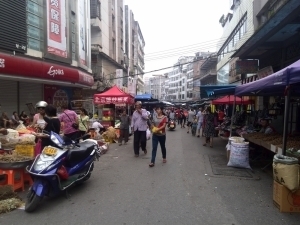
Luoding Market. Snakes, turtles, birds, fruits, veg etc.
9. Play Pool. Drink, eat and KTVThe last thing on my list of great things to do in Luoding is actually a few different things.
On the night we arrived we went to play pool (billiards) and have a few drinks. We decided against KTV (Karaoke) but it is something you can do.
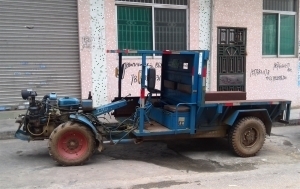
We just saw this vehicle and thought it was worth a picture, since I’ve never seen anything like it in the Western world.
Getting From Shunde to Luoding, ChinaGetting from Shunde to Luoding is a 4-6 hour bus ride away. It took 4 hours there, but traffic was a nightmare on the way back so the return journey was 6 hours. There’s one toilet stop. Tickets range from 90 to 110 rmb depending on the time of day you go. I advise to purchase your ticket one day in advance, especially duing the holiday season.
The bus leaves/arrives Shunde from the Da Liang bus station, and arrives/departs Luoding from the main bus station in Luoding.
Tip: To find the best accommodation, compare Hostelbookers.com and HotelTravel.com and to find the cheapest flights use CheapOair.comThe post 9 Great Things to Do in Luoding, Guangdong, China appeared first on Survive Travel.
September 29, 2014
7 Best Things to do Around Guangdong Ocean University, China
Tip: To find the best accommodation, compare Hostelbookers.com and HotelTravel.com and to find the cheapest flights use CheapOair.com
Discover the 7 best things to do around Guangdong Ocean University, China. While teaching or studying at Guangdong Ocean University, you will probably want things to do. Here’s a few ideas on best things to do around Guangdong Ocean University and some logistical information.
7 Best Things to do Around Guangdong Ocean UniversityActually, the best thing to do would be to just ask the other foreigners who are also teaching English at Guangdong Ocean University.
Ok, here it is. My list of 7 best things to do around Guangdong Ocean University.
1. EatThe first thing on my list of best things to do in around Guangdong Ocean University is to eat.
There’s tons of small restaurants out the front of the campus, with styles of foods from all over China.
Not surprisingly, this was my favorite thing to do whilst teaching English at Guangdong Ocean University, because my favorite thing in China in general is the food.
2. Go to HuguangyanHuguangyan is the Maar lake that is a 10 minute walk from the university. It is the largest volcanic lake in the world and has a bunch of stuff e.g. temples etc.
It’s 50Yuan for a single entry, or 60yuan for a 3 year pass. If you want the 3 year pass, get a student to help you because you can’t get it from the park, you need to get it from somewhere in town.
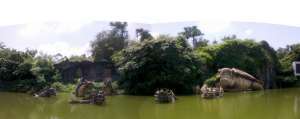
Huguangyan is just up the road (10 minute walk) from the university. It is the largest Maar lake in the world. Maar means volcanic.
3. Donghai BeachDonghai Beach is OK. Nothing on Australian beaches, but the water was warm and it is worth a look. They rope off an area of about 20 meters to swim in and freak out if your not in it. They blow whistles, scream a siren at you and wave red flags, but the person doing it is fully dressed so I guess if you actually drowned they would be like “I f*k’n told you to move between the ropes”.
Getting To Donghai From Guangdong Ocean University Main CampusTo get to the beach catch the number 4 from out the front of the university (Guangdong Ocean University, Main Campus) and get off under the bride. 2RMB. then catch another bus to Donghai, you’ll have to ask to make sure its the right one. This will cost under 10 rmb, like 7 or 10 depending on which bus you manage to get. Then they charge you 5 rmb to get into the beach. They’ll try to charge foreigners 10, but tell them your a local teacher and only pay 5.
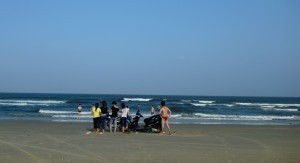
In China, the girls go into the water fully clothed an the men strip down to their red underwear. This is not uncommon. Also, you can’t swim outside of the 20 meters, but feel free to race your motorbike amongst the general beach population.
Get the Latest Survive Travel Books FREE! Click Here to Get Them.4. Play BilliardsThere are a few billiard places out the front.
I used to go to the cheap ones. The tables were crappy but it served it’s purpose and from what I can figure, was 3RMB per table, no matter how long you are there for. Go out the camps, just walk straight. Take a the last right (before the hotel). You’ll see the tables out the front.
If you want the indoors ones, with air con and nice tables, then it costs a bit more (quite a bit more). I think these ones are one street before.
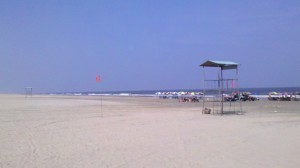
Donghai Beach
5. KaraokeKaraoke aka KTV is really popular in most Asian countries. There’s a couple of places outside the campus. We went to the one in the hotel. I can’t remember how much it cost, but they sell beer so it was a good night.
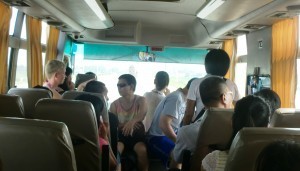
Bus to Donhai. Typical chinese bus experience
6. Do Stuff on CampusYoga, swimming, soccer, kickboxing etc. These things are on campus and you can participate if you want. Ask a student (or another teacher) to let you know the go.
7. Go Riding in the MountainsThe last thing on my list of best things to do in Guangdong Ocean University is also another of my favorites.
Get your hands on a push bike (they rent them out the front for cheap) and go for a ride in the mountains.

You can ride into the mountains and get some nice views.
Tip: To find the best accommodation, compare Hostelbookers.com and HotelTravel.com and to find the cheapest flights use CheapOair.comThe post 7 Best Things to do Around Guangdong Ocean University, China appeared first on Survive Travel.



